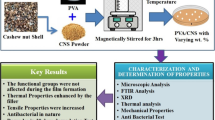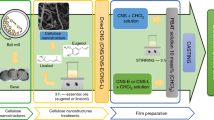Abstract
The bio-based polymer blend of polylactic acid (PLA)-polybutylene adipate-co-terephthalate (PBAT) incorporated with cashew shell biomass synthesized cardanol oil (CARD) was prepared by solution casting method. The various formulations were prepared with PLA/PBAT(90/10) polymer blend containing 1%, 3%, and 5 wt.% of cardanol oil. All the prepared PLA/PBAT films were subjected to characterization techniques such as surface morphology, Fourier transform infrared spectroscopy, mechanical, thermal stability, X-ray diffraction, film color, opacity, wettability, and antimicrobial properties. The FTIR and XRD results confirmed the effective miscibility and molecular interactions of cardanol oil in PLA/PBAT blend. Further, the results of TGA analysis showed thermal stability improvement in PLA/PBAT bio-based film by the addition of cardanol oil. The homogeneous distribution of cardanol oil droplets on the PLA/PBAT blend was confirmed by observed SEM and TEM images. The mechanical result proved that the addition of 5 wt.% of cardanol oil into the PLA/PBAT blend increases the elongation at break. Moreover the bio-based PLA/PBAT film shows good barrier against water vapor and a poor barrier against oxygen permeability. The presence of cardanol oil in the PLA/PBAT matrix helps to enhance the optical and wettability properties of prepared bio-based film. Finally, it is proved from the investigational results that the PLA/PBAT/cardanol biodegradable films may be recommended to use in food packaging applications wherever high flexibility, water vapor barrier, thermal stability, antibacterial resistance, and less water absorption properties are required.











Similar content being viewed by others
References
Han Y, Shi J, Mao L, Wang Z, Zhang L (2020) Improvement of compatibility and mechanical performances of PLA/PBAT composites with epoxidized soybean oil as compatibilizer. Ind Eng Chem Res 59(50):2177921790
Ben Samuel J, JulyesJaisingh S, Sivakumar K, Mayakannan AV, Arunprakash VR (2021) Visco-elastic, thermal, antimicrobial and dielectric behaviour of areca fibre-reinforced nano-silica and neem oil-toughened epoxy resin bio composite. Silicon 13(6):1703–1712
Sharma S, Barkauskaite S, Duffy B, Jaiswal AK, Jaiswal S (2020) Characterization and antimicrobial activity of biodegradable active packaging enriched with clove and thyme essential oil for food packaging application. Foods 9(8):1117
Hernández-López M, Correa-Pacheco ZN, Bautista-Baños S, Zavaleta-Avejar L, Benítez-Jiménez JJ, Sabino-Gutiérrez MA, Ortega-Gudiño P (2019) Bio-based composite fibers from pine essential oil and PLA/PBAT polymer blend. Morphological, physicochemical, thermal and mechanical characterization. Mater Chem Phys 234:345–353
Venkatesan R, Rajeshwari N, ThendralThiyagu P (2015) Preparation and mechanical properties of poly (butylene adipate-co-terephthalate) polyvinyl alcohol/SiO2 nanocomposite films for packaging applications. J Polym Mater 32(1):93–101
Correa-Pacheco ZN, Black-Solís JD, Ortega-Gudiño P, Sabino-Gutiérrez MA, Benítez-Jiménez JJ, Barajas-Cervantes A, Bautista-Baños S, HurtadoColmenares LB (2020) Preparation and characterization of bio-based PLA/PBAT and cinnamon essential oil polymer fibers and life-cycle assessment from hydrolytic degradation. Polymers 12(1):38
Sharma S, Jaiswal AK, Duffy B, Jaiswal S (2020) Ferulic acid incorporated active films based on poly (lactide)/poly (butylene adipate-co-terephthalate) blend for food packaging. Food Packag Shelf Life 24:100491
Fu Y, Wu G, Bian X, Zeng J, Weng Y (2020) Biodegradation behavior of poly (butylene adipate-co-terephthalate)(PBAT), poly (lactic acid)(PLA), and their blend in freshwater with sediment. Molecules 25(17):3946
Aliotta, L., Gigante, V., Acucella, O., Signori, F., & Lazzeri, A. (2020). Thermal, mechanical and micromechanical analysis of PLA/PBAT/POE-g-GMA extruded ternary blends. Front. Mater.
Zheng Y, Chen L, Wang X, Guangshun Wu (2020) Modification of renewable cardanol onto carbon fiber for the improved interfacial properties of advanced polymer composites. Polymers 12(1):45
Ali M, Yunhua Lu, Ahmed S, Khanal S, Shiai Xu (2020) Effect of modified cardanol as secondary plasticizer on thermal and mechanical properties of soft polyvinyl chloride. ACS Omega 5(28):17111–17117
Rubbi Fazlay, Khairul Habib R, Saidur NavidAslfattahi, Yahya Syed Mohd, Das Likhan (2020) Performance optimization of a hybrid PV/T solar system using soybean oil/MXene nanofluids as A new class of heat transfer fluids. Solar Energy 208:124–138
da Silva JMF, Soares BG (2021) Epoxidized cardanol-based prepolymer as promising biobased compatibilizing agent for PLA/PBAT blends. Polymer Testing 93:106889
Krishnadevi K, Devaraju S, Sriharshitha S, Alagar M, KeerthiPriya Y (2020) Environmentally sustainable rice husk ash reinforced cardanol based polybenzoxazine bio-composites for insulation applications. Polymer Bulletin 77(5):2501–2520
Balaji A, Udhayasankar R, Karthikeyan B, Swaminathan J, Purushothaman R (2020) Mechanical and thermal characterization of bagasse fiber/coconut shell particle hybrid biocomposites reinforced with cardanol resin. Results in Chemistry 2:100056
Nofar Mohammadreza, Salehiyan Reza, Ciftci Umit, Jalali Amirjalal, Durmuş Ali (2020) Ductility improvements of PLA-based binary and ternary blends with controlled morphology using PBAT, PBSA, and nanoclay. Compos Part B Eng 182:107661
Han Yi, Shi J, Mao L, Wang Z, Zhang L (2020) Improvement of compatibility and mechanical performances of PLA/PBAT composites with epoxidized soybean oil as compatibilizer. Ind Eng Chem Res 59(50):21779–21790
Rajadurai A (2016) Thermo-mechanical characterization of siliconized E-glass fiber/hematite particles reinforced epoxy resin hybrid composite. Appl Surf Sci 384:99–106
Prakash VR Arun, Viswanthan R (2019) Fabrication and characterization of echinoidea spike particles and kenaf natural fibre-reinforced Azadirachta-Indica blended epoxy multi-hybrid bio composite. Compos Part A Appl Sci Manuf 118:317–326
Dinesh, T., A. Kadirvel, and P. Hariharan. "Thermo-mechanical and wear behaviour of surface-treated pineapple woven fibre and nano-silica dispersed mahua oil toughened epoxy composite". Silicon (2020): 1–10.
Kumar Mukesh, Mohanty S, Nayak SK, RahailParvaiz M (2010) Effect of glycidyl methacrylate (GMA) on the thermal, mechanical and morphological property of biodegradable PLA/PBAT blend and its nanocomposites. Bioresour Technol 101(21):8406–8415
Hernández-López Mónica, Correa-Pacheco ZormyNacary, Bautista-Baños Silvia, Zavaleta-Avejar Leonor, Benítez-Jiménez José Jesús, Sabino-Gutiérrez Marcos Antonio, Ortega-Gudiño Pedro (2019) Bio-based composite fibers from pine essential oil and PLA/PBAT polymer blend. Morphological, physicochemical, thermal and mechanical characterization. Mater Chem Phys 234:345–353
Prakash VR Arun, Viswanathan R (2018) Microwave-shielding behavior of silanized Cu and Cu–Fe 3 O 4 compound particle-reinforced epoxy resin composite in E-, F-, I-, and J-band frequencies. Polym Bull 75(9):4207–4225
VR, Arun Prakash, V. Jayaseelan, T. Mothilal, Manoj Kumar, Melvin Victor Depoures, D. Jayabalakrishnan, and G. Ramesh. "Effect of silicon coupling grafted ferric oxide and e-glass fibre in thermal stability, wear and tensile fatigue behaviour of epoxy hybrid composite." Silicon (2019): 1–12.
Adrar S, Habi A, Ajji A, Grohens Y (2018) Synergistic effects in epoxy functionalized graphene and modified organo-montmorillonite PLA/PBAT blends. Appl Clay Sci 157:65–75
Thiyagu T. Thendral, Rajeswari N (2019) Effect of nanosilica and neem tree oil on antimicrobial, thermal, mechanical and electrical insulate of biodegradable composite film. Mater Res Express 6(9):095410
Venkatesan R, Rajeswari N, ThendralThiyagu T (2017) Preparation, characterization and mechanical properties of k-Carrageenan/$$\hbox {SiO} _ {2} $$ SiO 2 nanocomposite films for antimicrobial food packaging. Bull Mater Sci 40(3):609–614
Venkatesan, Raja, T. Thendral Thiyagu, and N. Rajeswari. "Zinc composite materials and food packaging." Composites Materials for Food Packaging (2018): 153–175.
Lee Sumkun, Kim Mingeun, Song Hyeong Yong, Hyun Kyu (2019) Characterization of the effect of clay on morphological evaluations of PLA/biodegradable polymer blends by FT-rheology. Macromolecules 52(20):7904–7919
Rodrigues Samara CS, Silva Fabrício Almeida, de Mesquita Laura H, de Carvalho Tatianny S, Alves Rudy Folkersma, dos Regilda S, Araújo RM, Oliveira Amanda D, Barbosa Renata (2021) Preparation and characterization of polymeric films based on PLA, PBAT and corn starch and babassu mesocarp starch by flat extrusion. Mater Res Express 8(3):035305
Moustafa Hesham, El Kissi Nadia, Abou-Kandil Ahmed I, Abdel-Aziz Mohamed S, Dufresne Alain (2017) PLA/PBAT bionanocomposites with antimicrobial natural rosin for green packaging. ACS Appl Mater Interfaces 9(23):20132–20141
Author information
Authors and Affiliations
Corresponding author
Additional information
Publisher's Note
Springer Nature remains neutral with regard to jurisdictional claims in published maps and institutional affiliations.
Rights and permissions
About this article
Cite this article
Thiyagu, T.T., J.V, S.P.K., P, G. et al. Effect of cashew shell biomass synthesized cardanol oil green compatibilizer on flexibility, barrier, thermal, and wettability of PLA/PBAT biocomposite films. Biomass Conv. Bioref. 13, 11841–11851 (2023). https://doi.org/10.1007/s13399-021-01941-9
Received:
Revised:
Accepted:
Published:
Issue Date:
DOI: https://doi.org/10.1007/s13399-021-01941-9




